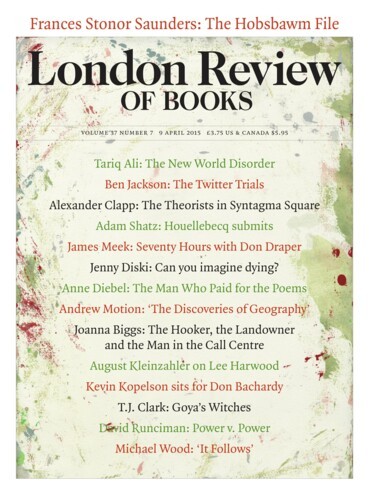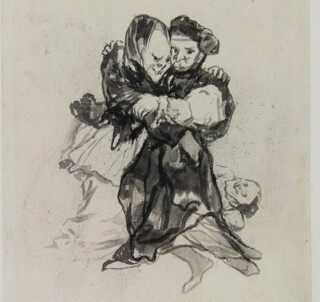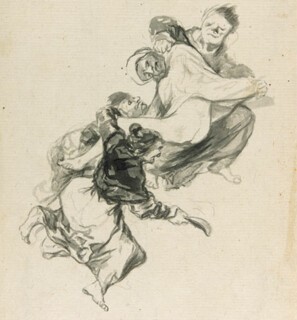It’s hard to pick a single image to stand for Goya’s Album D, whose sad totality – a triumph of reconstitution, gathered from collections across the world – is the centrepiece of the exhibition Goya: The Witches and Old Women Album (at the Courtauld until 25 May).* Repetition – a wild piling of imbecility on imbecility – is part of the Goya effect. At the show, I tried the experiment of starting at page 1 and giving each sheet of the album three or four minutes, just reading the caption and staring, not turning for solace to the wall labels. I made it as far as page 13 (out of 23) and then stumbled exhausted to a bench, feeling a strange mixture of exultation and disgust. Perhaps page 10, entitled Visiones, is representative. A couple, roughly male and female, are holding one another in a sort of embrace. Garments get in the way. Ink encircles the heavy folds. The woman seems to be enjoying herself more than the man. At first sight both figures come across as standing on the ground, maybe dancing, but then one notices the slippered feet of the man at right – well, is he a man? – and empty space begins to slip away from the pair. They are revolving in a void. How dreadful and delicate the man’s paw on the old woman’s sleeve! How horrible the soft groping of her hand at his hip. No wonder the undressed hag who is lying (or floating) behind the duo is grinning like a death’s head.
Visiones is by no means the worst – the most pitiless and pornographic – of the album’s sheets. Page 6, Sueño de azotes (‘Dream of Flogging’) far outdoes it. The body whose slack bum is revealed by the figure top right – is the figure male or female? Might its billowing cassock be that of a monk? – looks generally drained and lifeless, and could be a cadaver. Or perhaps he (?) is just shamming, waiting to be aroused by the woman’s cowhide whip. Again the empty page becomes emptier the longer we look. The woman’s toes splay out in zero gravity. Another mostly hidden observer, head supported by the corpse’s thigh, stares at the victim/client’s face, desperate to see its last gasp or first spasm.
Is that me, the ‘mostly hidden observer’? Certainly part of what had me reeling away from page 13 was a growing uncertainty about ‘where I stood’ – or floated – in relation to the things Goya was showing. I couldn’t put a name to the quality of Goya’s laughter, or decide how much I wanted to join in. Isn’t laughter essentially collusive – a sudden explosive bonding experience? That’s what evolutionary biologists think. But I wasn’t sure that Goya expected, or even wanted, me to laugh along with him. Maybe that was because Goya himself – the thought occurred – didn’t understand if he was laughing or not; and in either case, whether he was or wasn’t, what laughing (or failing to laugh) was for. Laughter, we know from Freud (or the noise level in a London restaurant), is bound up with aggression. The bond forged by shuddering ribs is most often aimed at belittlement or exclusion. But not unfailingly, and maybe not fundamentally. Daumier could be cruel, but almost always to be kind: his generosity towards the bourgeoisie he lampooned is the key to his strength. Art historians try to persuade us that Bruegel’s laughter had a condescending Reformation edge to it – those lascivious peasants and hopeless cripples! – but we go on looking and are not convinced. But Goya? What is he laughing at? Why does he need to repeat the joke till a guffaw becomes a shriek? Did he know himself?
Repetition and variation in his drawings – each one intense and definitive, monotony coexisting with inventiveness – lead nowhere. That is what seems immediately ‘modern’ about them, and what puts most pressure on our notion of (our hopes for) art. Repetition and variation in the albums do not open out into a steadily broadening range of emotion, or a deepening sense of identification and sympathy. There seem to be difficult things in the world, like old age and human cruelty and petty malice and the ugliness of lust, to which I (Goya) am drawn, and which I can’t put down – can’t get used to. ‘Repetition compulsion’ doesn’t quite capture it, since in Goya there is never a feeling of the trauma being dwelled on in order to be mastered. There’s not even the feeling that the horror is a trauma, or that drawing necessarily lessens it. Maybe the opposite. It isolates it; it specifies it; it gives it the blank of the page to live in.
Lawrence Gowing once said that Goya’s achievement ‘transcended the conditions of painting’ (or drawing) and that ‘Goya’s ultimate message might have been conveyed by a writer of comparable greatness in words.’ I’m not sure this is true. I see no one comparable to Goya in literature. Sade is his contemporary antithesis. The wordlessness of Goya’s pages – the way his images annihilate their scribbled captions, and never stop saying ‘De esto nada se sabe’ (‘Nothing is known of this’) – seems intrinsic to their effect. Wordlessness in Goya is adequacy to the facts, or the fears, or the fascination, or whatever it is that can’t be got rid of by being pictured. That is what makes the cruelty in the albums go on drifting and distending, like the spaces surrounding the old fools – becoming in the end a form of, or a substitute for, acceptance. This is old man’s art – Goya was in his seventies, as profoundly deaf as his contemporary Beethoven, when he did Album D – and in old age acceptance and abhorrence often keep company. The smug look of that monk with the corpse!
Send Letters To:
The Editor
London Review of Books,
28 Little Russell Street
London, WC1A 2HN
letters@lrb.co.uk
Please include name, address, and a telephone number.



